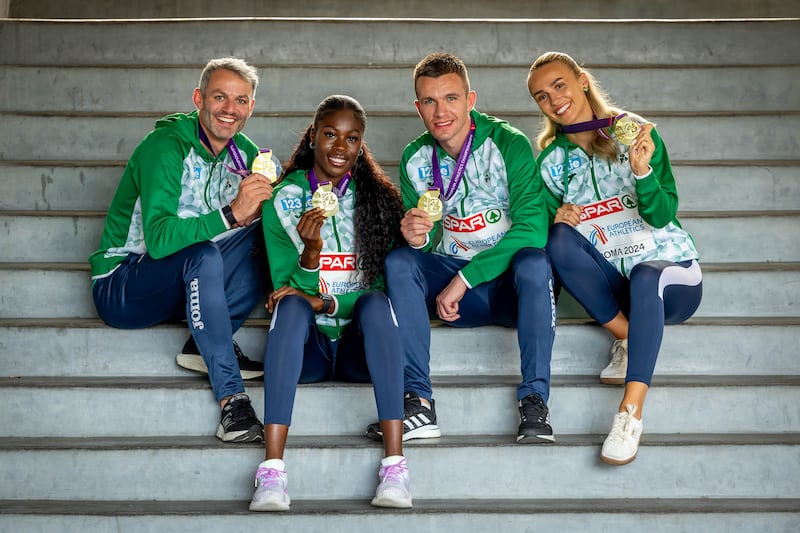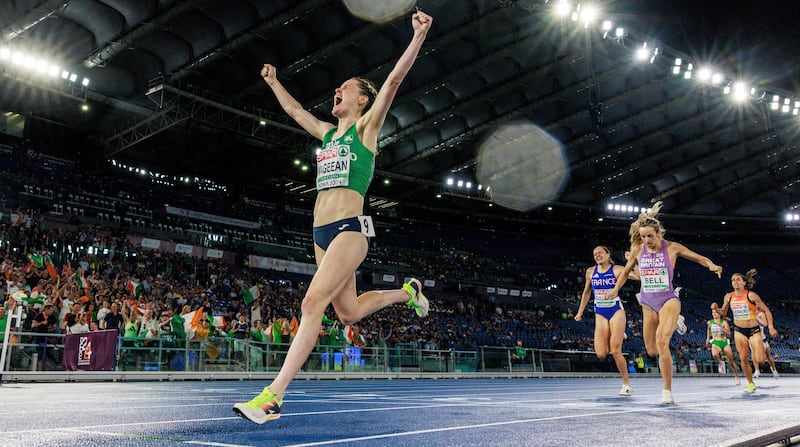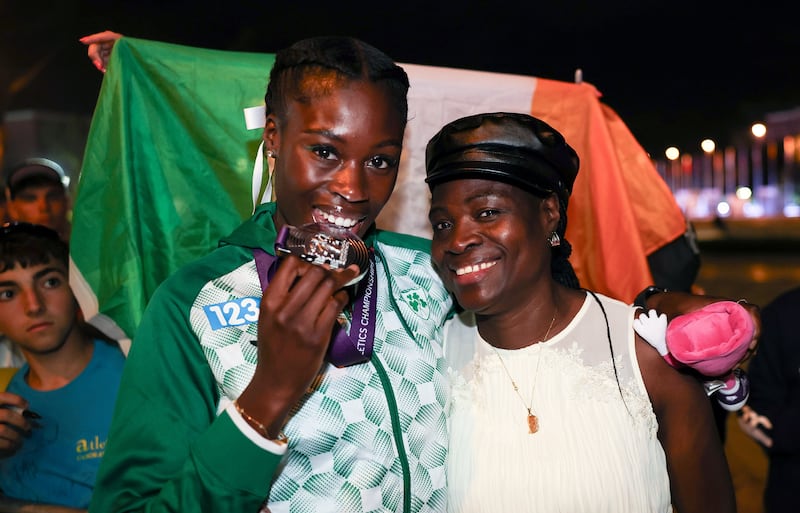Show me the medals. If any further evidence was needed of what that record four-medal haul from the European Championships in Rome has done for the profile of Irish athletics over the past week, consider Friday morning’s invite to Government Buildings from Taoiseach Simon Harris to show some of them off around there too.
Clearly, nothing beats medals of any colour as the measure of championship success, same as when the lack of them might be the measure of some failure, with Ireland’s two gold and two silver – neatly spread between two relay and two individual events – also enough to draw in the sort of viewing figures on RTÉ that would top The Late Late Show.
Rome also made for Irish athletics history, the four-medal haul surpassing the three won in Budapest back in 1998, which included two individual golds for Sonia O’Sullivan (a 5,000m-10,000m double). With that Ireland also broke into the top 10 on the final medal table in Rome for the first time, ahead of superpowers such as Germany and Sweden.
All of which also begs the question then of why, after those six long days and even longer nights of action inside the old Stadio Olimpico, these were the most successful championships for Ireland.
READ MORE
Firstly, none of the medals were unexpected, and certainly none were any overnight success. The three key ingredients in any sporting success story – the coaching, the facilities and the funding – have all been steadily improving in Irish athletics over the last decade, particularly around the Sport Ireland campus and indoor arena in Abbotstown.
For decades, the lack of proper indoor facilities was particularly galling, and it wasn’t until 2013, after more than 30 years of waiting, when the doors were opened on the World Athletics standard indoor track at the Athlone Institute of Technology, which Eamonn Coghlan himself described as “the most historic day in Irish athletics”. This current generation of athletes are starting to show the benefits of that investment now.
The Sport Ireland Institute also now offers the sort of elite athlete support and sports science backup which was largely absent before, that level of professionalism further trickling down to club and grassroots level.

Athletics Ireland has also extended its coaching staff significantly over the last three or four years, under high-performance director Paul McNamara. This includes the recent addition of Mark Kennelly, who ran the Olympic marathon in London in 2012, as endurance running performance lead. McNamara also has plenty of international running experience of his own.
Things have also been improving on the participation and popularity front, right across the sport, with Athletics Ireland last year reaching its highest membership figure of 63,578, and hitting more than 60,000 for 2024 at this point of the year already.
For many years the lack of easy access to a running track around Dublin, outside of the Morton Stadium in Santry, also seemed to be holding back the sport, but in the last few years UCD and Dundrum South Dublin have added excellent new facilities of their own.
[ European Athletics Championships: How Ireland’s historic week in Rome unfoldedOpens in new window ]
Consider, too, the perfect mix of youth and experience of these medal-winning athletes. Ciara Mageean, at age 32, first won a world under-20 silver medal in the 1,500m back in 2010, and her 1,500m gold medal in Rome was perhaps the least surprising of the lot. It has been 20 years in the making since she first took up athletics as a youngster in Portaferry, and she is the first Irish athlete to complete the set of European gold (2024), silver (2022) and bronze (2016).
After a couple of setbacks along the way, she also moved to the New Balance training group in Manchester in 2019, under coach Helen Clitheroe. That has, no doubt, brought her further on again, given the competitive nature of that group of athletes.
It helped, too, that Ireland sent its largest team of athletes to Rome, and there was unquestionably a greater depth of talent and experience about it too. The women’s 4x400m relay certainly rose to the occasion during Wednesday night’s closing session, Sophie Becker, Rhasidat Adeleke, Phil Healy and Sharlene Mawdsley taking a full 1.7 seconds off their previous Irish record to nail silver.
Though still only 21, Adeleke is already a seasoned championship runner, winning underage championship medals on the European and global stage since age 15. She has continued to make extraordinary progress since her move to the University of Texas in 2021, the highly competitive NCAA system clearly to her liking.
Of that relay quartet, Healy was running in her fifth European Championships. Formerly the fastest Irish woman over 100m and 200m, she was by her own admission further motivated by her disappointing run in the individual 200m. Like Mageean, Healy has had plenty of setbacks over the years, and her now vast experience also proved telling in the final showdown.

Mawdsley has made arguably the biggest breakthrough of any Irish athlete this year, already shining with Adeleke when anchoring both the mixed and women’s 4x400m relay teams to Olympic qualification at the World Relays in the Bahamas last month, then bronze medals in the mixed final.
Last month, she also secured her individual 400m qualifying spot for Paris, improving her best from 51.09 to 50.72, and the 25-year-old is clearly now coming into her athletic prime, running a remarkable five races in six days in Rome.
Her success is just reward too for her long-serving coach Gary Ryan, Tipperary’s two-time Olympian in Atlanta 1996 and Sydney 2000. He took Mawdsley under his wing in 2018, at a time when she was in danger of drifting away from the sport completely, and his input has been critical.
The mixed relay gold won by Chris O’Donnell, Adeleke, Thomas Barr and Mawdsley on the opening night last Friday was certainly no accident. Although this is a relatively new event, O’Donnell was part of the team that made the Olympic final in Tokyo. And for Barr, who at 31 was racing his sixth successive European Championships, six years after winning bronze in the 400m hurdles, there was ample motivation to make the most of his chance too.
“Often when I was younger and when we were making finals, that was like, ‘wow, this is amazing’,” Barr said of the changing mentality of Irish athletics. “If we were top-eight in Europe or top-12 in the world, that was always seen as a really big achievement, but we’ve raised our standards. Now it’s like, ‘I’m disappointed not to make a final and there’s going to be people who are disappointed for me not making a final.’ It’s where we should be aiming.”
It should also be noted, though, that the medal success of these European Championships will be extremely difficult to match at the Paris Olympics, which are an entirely different prospect for any athlete. One hint is in the four-year cycle.
Before Rome, O’Sullivan had been the sole gold medal winner for Ireland in the 90-year history of these championships, first staged in Turin in 1934. Her first victory in the 3,000m in Helsinki in 1994 was then only Ireland’s fourth medal in all.
What is certain is that O’Sullivan was in no way surprised by the four medals won in Rome, or the colour of them. If anything, Ireland could have won more, but few athletes also better understand the sort of step up required to reach the Olympic medal podium.

“We’d all predicted it beforehand, even if some people thought that was mad,” says O’Sullivan, who was part of RTÉ's studio panel during their championship coverage. “It was unbelievable, though, the amount of people who were talking about athletics, and before that probably didn’t even know the event was on. All of sudden, everyone was tuning in, it was crazy. But there’s still a long way to go for the Irish athletes, it’s not like the end of the season, it’s not even the middle of it.
“And Olympic medals are really, really difficult to get. Much more difficult than the number of European medals. Just look at the number of European athletics medals we have now, compared to the Olympics.”
In truth, with a little more luck Ireland might have fared even better. Sarah Healy ran well to finish seventh in the 1,500m, the 23-year-old running her first senior championship final. Her training partner Georgia Bell won the silver medal for Britain and Healy regularly gets the better of Bell in training, and is no doubt a future medal prospect. And if Sarah Lavin hadn’t been the one athlete to clip a hurdle in her 100m hurdles final, there just might have been another medal there too.
But with that rising profile comes greater expectation too. It was both telling and comforting that neither Adeleke nor Mageean took part in any sort of medal homecoming show in Dublin. Adeleke is already now back at her training base in Austin, Texas, and Mageean back at hers in Manchester, their eyes already turning to the Olympics. That reflects the attitude of these athletes too, knowing there are bigger and more important prizes to come.
There is always room for further improvement in funding, and the scale of investment in athletics coaching is still some distance off that of other European nations.
This year, Sport Ireland announced high-performance funding for the Paris Olympic cycle with an additional investment of €25 million, up to €89 million overall for the four-year cycle, a substantial increase on the €59 million which was invested in the four-year Tokyo cycle.
Rowing Ireland topped the high-performance investment with €1,093,334 for 2024, ahead of Paralympics Ireland (€1,000,000), the Irish Athletic Boxing Association (€965,000), and Athletics Ireland (€841,666). Rowing Ireland also has 16 athletes on this top-tier funding of €40,000, compared to four in boxing and just three in athletics.
But the medal success in Rome will now push more Irish athletes into that top bracket, all well earned and deserved.















